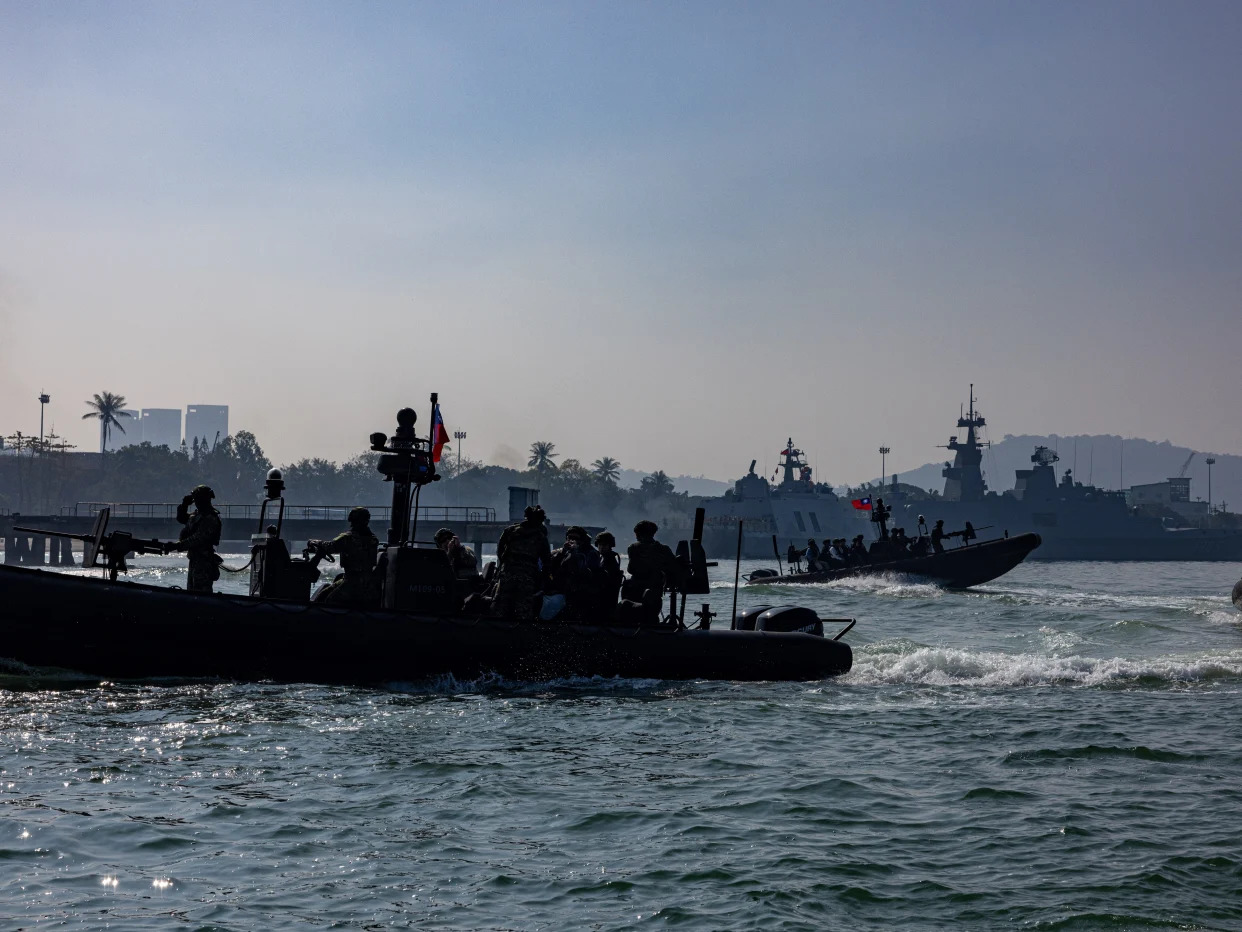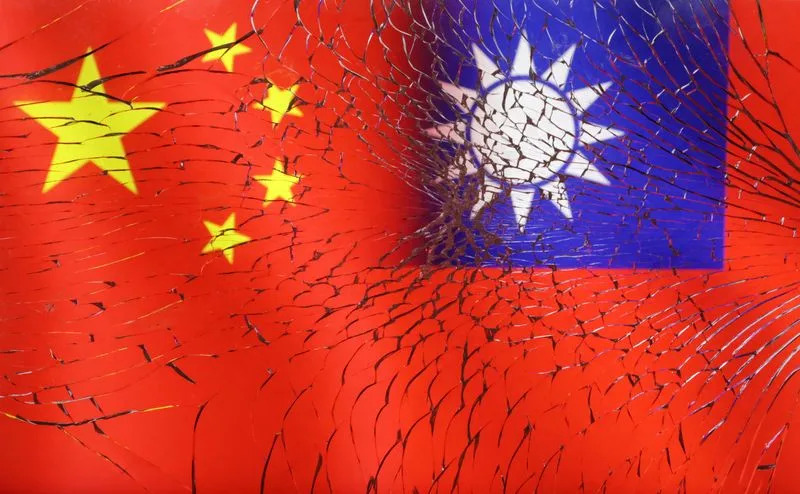Chris Panella
Thu, May 16, 2024

The US is worried about an invasion, but China could take control of Taiwan without firing a shot, war experts warn
The US and its allies are focused on preventing a Chinese invasion of Taiwan.
A new report argues there's a lack of readiness for other ways China could take control of Taiwan.
An aggressive Chinese coercion campaign is far more likely than an invasion and already happening, experts warn.
With the US and its allies focused on what a Chinese invasion of Taiwan could look like, and how American forces could defend Taiwan if necessary, they're missing a glaring alternative strategy China could employ to capture Taiwan, a new report argues.
Defense experts say that an aggressive Chinese coercion campaign, short of war but still threatening, is more likely than a full-scale invasion and the US needs to prepare for such an event.
A new report co-authored by war experts from the American Enterprise Institute and the Institute for the Study of War explores a scenario where China undergoes a "coercion campaign that remains far short of invasion but nevertheless brings Taiwan under Beijing's control," identifying such an event as a "significant gap in US strategic thought."
Elements of such a campaign are already underway and include China's military exercises both in the Taiwan Strait and around the island, which are growing in scale and raising worries about escalation. Economic and diplomatic pressure is notable, and Chinese misinformation operations and the potential to slowly set up a blockade of Taiwan are also concerns.
The increasing Chinese military presence around Taiwan, the report says, could exhaust and overwhelm Taiwan's military and fuel a narrative that it is unable to defend the island, decreasing "trust in the military and feelings of security among the Taiwanese populace."

Taiwan's AAV7 amphibious assault vehicle maneuvers across the sea during the Han Kuang military exercise, which simulates China's People's Liberation Army (PLA) invading the island, on July 28, 2022 in Pingtung, Taiwan.Annabelle Chih/Getty Images
The report identifies four things key to resisting Chinese coercion. The first is a US-Taiwanese strategic relationship that foregoes concerns that "cooperation directly precipitates further escalation, whereas peace and prosperity are just around the corner if this partnership is halted."
Second, Taiwan's government must function despite Chinese efforts to undermine it in the eyes of the Taiwanese people through things like "economic warfare, cyber warfare, sabotage, rigorous (and pseudo-legal) inspections of ships carrying goods to Taiwan, air and sea closures, electronic warfare, and propaganda critical of government mismanagement."
These efforts include significantly degrading Taiwan's essential services, like clean water and electricity.
The third point is that Taiwanese people must resist Chinese "cognitive and psychological campaigns" aimed at breaking their rejection of the Chinese government, including "intimidating supporters of resistance, sowing doubt and fear among the population, and generating demands to trade political concessions for peace."
And lastly, there has to be resistance against "widespread information campaigns" that "aim to decrease the US public's and political leadership's willingness to support Taiwan." Such campaigns are already occurring, prompting anxiety that the US public and government may see getting involved in defending Taiwan as heightening risks of war at a significant cost with little to gain. The AEI and ISW experts argue that is not the case.
Notably, the report says that "Taiwan is strategically vital to the larger US-led coalition to contain" China, arguing that a US-friendly Taiwan links America's allies in the northwestern Pacific with US partners and allies to the south."
A China-controlled Taiwan, however, "would become a springboard for further PRC aggression and would seriously compromise the US-led coalition's ability to operate cohesively."

A US-made AH-1W Super Cobra helicopter launches flares during an annual drill at the a military base in the eastern city of Hualien on January 30, 2018.MANDY CHENG/AFP via Getty Images
The authors of the new report present coordinated actions China could pursue to prompt Taiwan and its partners to accept reunification, referring to it as a "short-of-war coercion course of action."
Some of Beijing's biggest problems are Taiwanese resistance to China, which continues to grow, especially after the historic election of Democratic Progressive Party candidate Lai Ching-te, who is currently the vice president, in January, and continued support from the US and its regional allies.
The new report looks at a hypothetical timeline that begins with the inauguration of Lai this month and leads into 2028, imaging how China and Taiwan could, by that point, come to a "peace" agreement. China could ultimately be successful in such a campaign, the authors say, if the US and its allies fail to recognize Beijing's coercive tactics or strategically plan to deter them.
The US must clearly "recognize the possibility and danger of a coercion campaign that is far more intense than the one currently ongoing against Taiwan and develop ways to prevent Taiwan's isolation through means short of war," they write.
The report's authors argue that "increased efforts in the information domain will be key to ensuring that the US government and friendly international audiences do not fall prey to [Chinese] information operations intended to reshape the way Americans and key international actors think."

CM-11 tanks fire artillery during the 2-day live-fire drill, amid intensifying threats military from China, in Pingtung county, Taiwan, 7 September 2022.Ceng Shou Yi/NurPhoto via Getty Images
US-Taiwanese relations and concerns about an aggressive China in the Pacific region are often at the forefront of the minds of US officials and experts, but the focus is frequently on hard power elements, even if there is recognition of some of the coercive aspects of Chinese behavior.
In March, US Navy Adm. John Aquilano, then the commander of US Indo-Pacific Command, stressed that China was pursuing a massive military build-up not seen since World War II and "all indications" pointed to it "meeting President Xi Jinping's directive to be ready to invade Taiwan by 2027." He also told the US Armed Services House Committee China's actions indicated it would ready to unify Taiwan by force, if necessary.
Aquilano urged lawmakers to intensify the US' military development and posturing in the Pacific in order to deter such a fight.
And, earlier this month, over a dozen US lawmakers wrote to US Navy Secretary Carlos Del Toro and Air Force Secretary Frank Kendall, raising concerns about what preparations were being made to harden the US presence in the Pacific and deter military action from China.
Of the lawmakers' concerns, the most prominent appeared to be the lack of active and passive defenses protecting US bases in the area, specifically on Guam and in Japan. "We are concerned about the alarming lack of urgency by the Department of Defense in adopting such defensive measures," they wrote, adding that "it is apparent that the Pentagon is not urgently pursuing needed passive defenses" to harden US bases and airfields from a vicious, preemptive strike by China's threatening missile force
Tracking China's 'grey zone' balloon flights over Taiwan
Thu, May 16, 2024

Illustration shows Chinese and Taiwanese flags
By Jackie Gu and Yimou Lee
TAIPEI (Reuters) - About a month before Taiwan's January presidential election, China began sending intruders over the Taiwan Strait: more than 100 balloons, some of which passed through the island's airspace or busy, Taipei-controlled air corridors for civil aviation.
Experts say the balloons could be psychological warfare, carry surveillance tools or simply gather meteorological data. On some days, as many as eight were detected within a few hours; at other times, weeks passed without any balloons at all. In the week leading up to Taiwan's presidential election on Jan. 13, an average of three balloons were spotted each day.
Then on April 11, they stopped altogether.
The increased frequency has raised alarms both domestically and abroad.
A senior Taiwanese security official briefed on the matter said Chinese balloon flights near Taiwan took place on an "unprecedented scale" in the weeks leading up to Taiwan's elections and described the incidents as part of a Chinese pressure campaign – so-called grey-zone warfare designed to exhaust a foe using irregular tactics without open combat.
Taiwan inaugurates its new president, Lai Ching-te, on May 20. China, which views democratically governed Taiwan as its own territory despite the island's objections, has a strong dislike of Lai, believing him to be a dangerous "separatist", whose repeated offers of talks it has rejected, including one in May.
China's defence ministry did not respond to a request for comment.
China's Taiwan Affairs Office referred Reuters to its comment on Jan. 31, in which it dismissed complaints about the balloons, saying they were for meteorological purposes and should not be hyped up for political reasons.
Before Dec. 8, balloon data was not public, making historical comparisons impossible.
But Jan Jyh-horng, the deputy head and spokesperson of the Mainland Affairs Council, Taiwan's top China policy-making body, told Reuters that in the past, a balloon would be spotted "maybe once a month".
Between December 2023 and April 2024, more than four balloons were detected on eight separate days. In total, just over a hundred balloons were flown during that period.
Three Taiwanese officials briefed on the matter confirmed that the number of Chinese balloons had increased significantly in recent months. The majority are weather balloons collecting atmospheric data, including wind, temperature and humidity, they said, but Taiwan still sees them as Chinese harassment.
The balloons have flown at an altitude of 11,000 to 38,000 feet, with a mean altitude of 22,294 feet – well under the usual altitude for meteorological balloons. According to the U.S. National Weather Service, weather balloons typically reach altitudes of more than 100,000 feet.
"Sending them over at that kind of altitude is dangerous," said Alexander Neill, strategic adviser on Indo-Pacific geopolitics formerly at the International Institute for Strategic Studies and the Royal United Services Institute. "You are within air traffic corridors, and the potential for a collision is concerning."
Jan agreed, saying the balloons are threats to aviation safety.
"They fly very slowly while planes move speedily," he said. "It could be too late when they were spotted, if they were sucked into the engines."
China's most frequent form of "grey zone" activity has been the almost daily air force and navy missions in the waters and skies around Taiwan, forcing the island's armed forces to repeatedly scramble to see off the intruders.
Other tactics Taiwanese officials have expressed concern about include sand dredging close to the Taiwan-controlled Matsu islands, which sit near the Chinese coast.
(For an interactive graphic tracking balloon’s over Taiwan, click )
A second senior Taiwanese senior security official said, citing intelligence gathered by Taiwan, that the data potentially collected by the balloons would be useful for the PLA's rocket forces, because atmospheric factors could affect missile launches.
"If China was planning to mount an air assault onto Taiwan, they would need to understand the meteorological conditions and wind patterns of the island," Neill said.
Wang Ting-yu, a senior lawmaker for Taiwan's ruling Democratic Progressive Party and chair of parliament's foreign affairs and defence committee, told Reuters balloons are hard for military radars to detect unless their sensitivity is set to high levels.
But ultra-sensitive radars are likely to spot objects such as birds, and as a result, Taiwan's military might miss other vital targets such as incoming missiles.
"It's a challenging task," he said.
Raymond Kuo, director of the RAND Corporation's Taiwan Policy Initiative, says he thinks the purpose of the balloons is primarily psychological.
"I personally am sceptical of what additional intelligence China could get from balloons that they couldn't get from other platforms," Kuo said. "I think they're mostly meant to signal to Taiwan that they can't even defend their airspace."
(Reporting by Jackie Gu and Yimou Lee; Additional reporting by Ben Blanchard, and Ryan Woo in Beijing. Editing by Gerry Doyle)
No comments:
Post a Comment